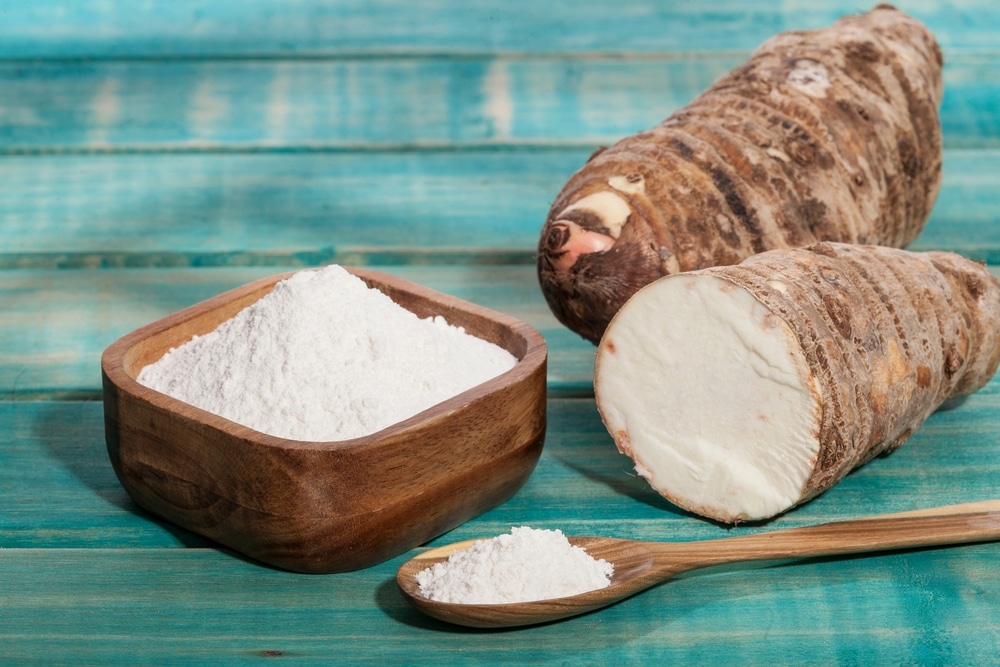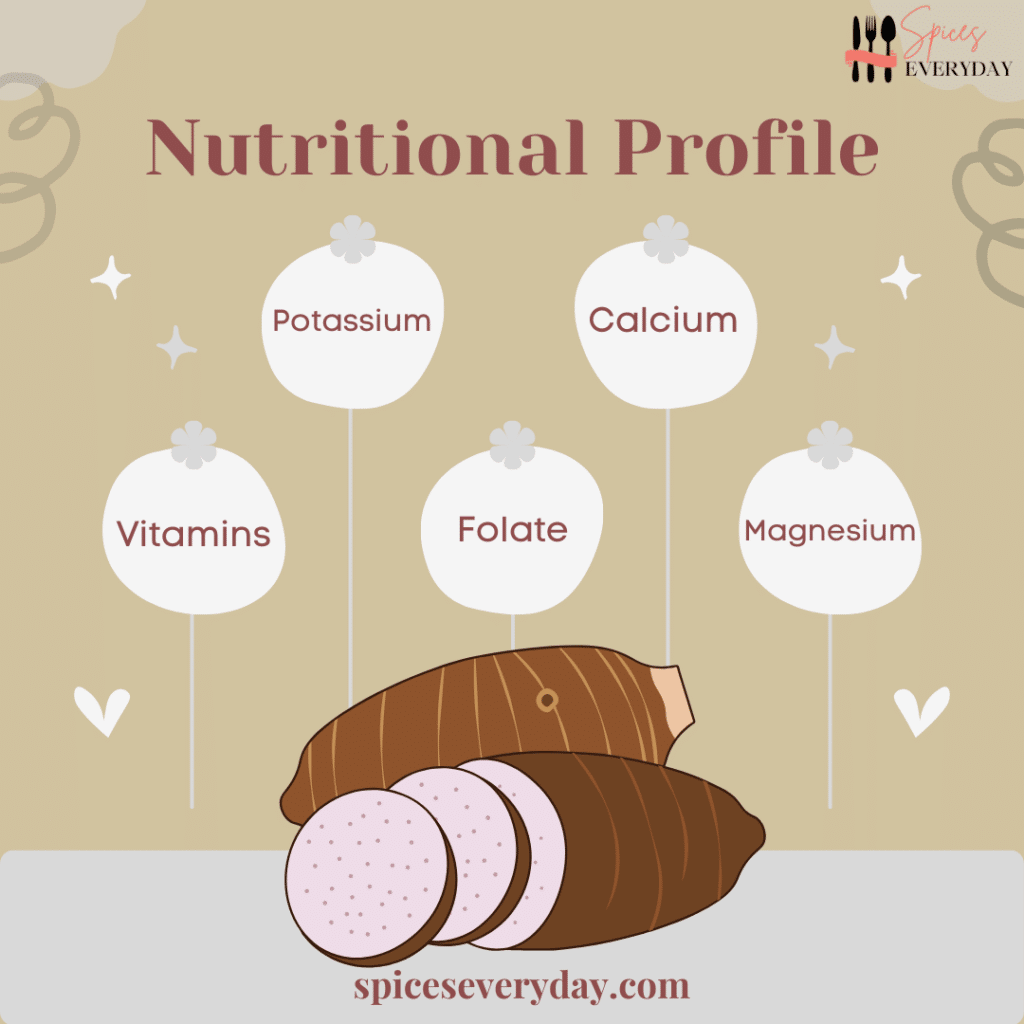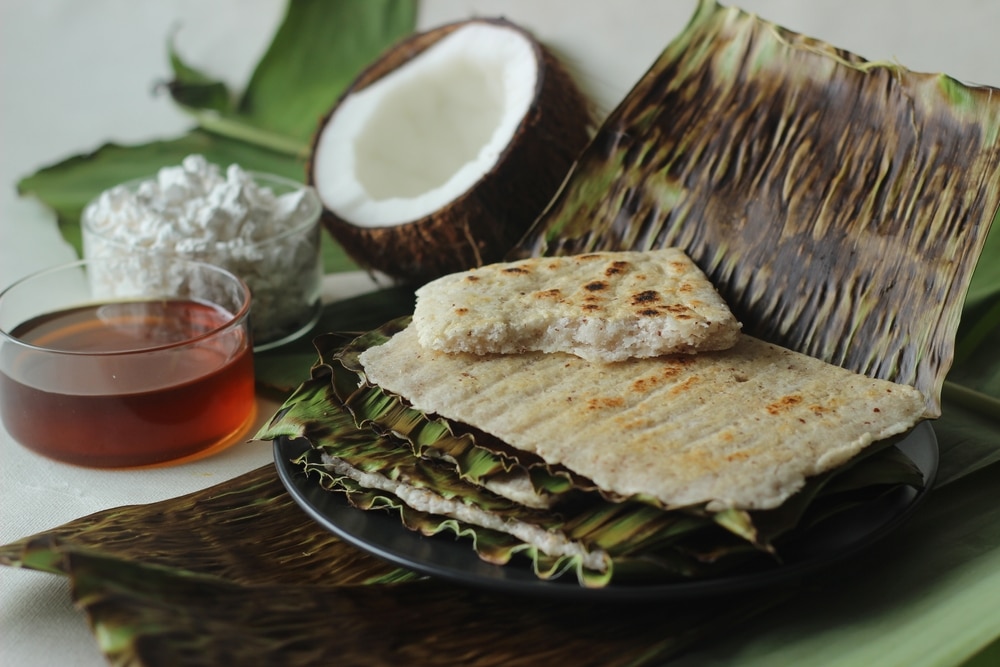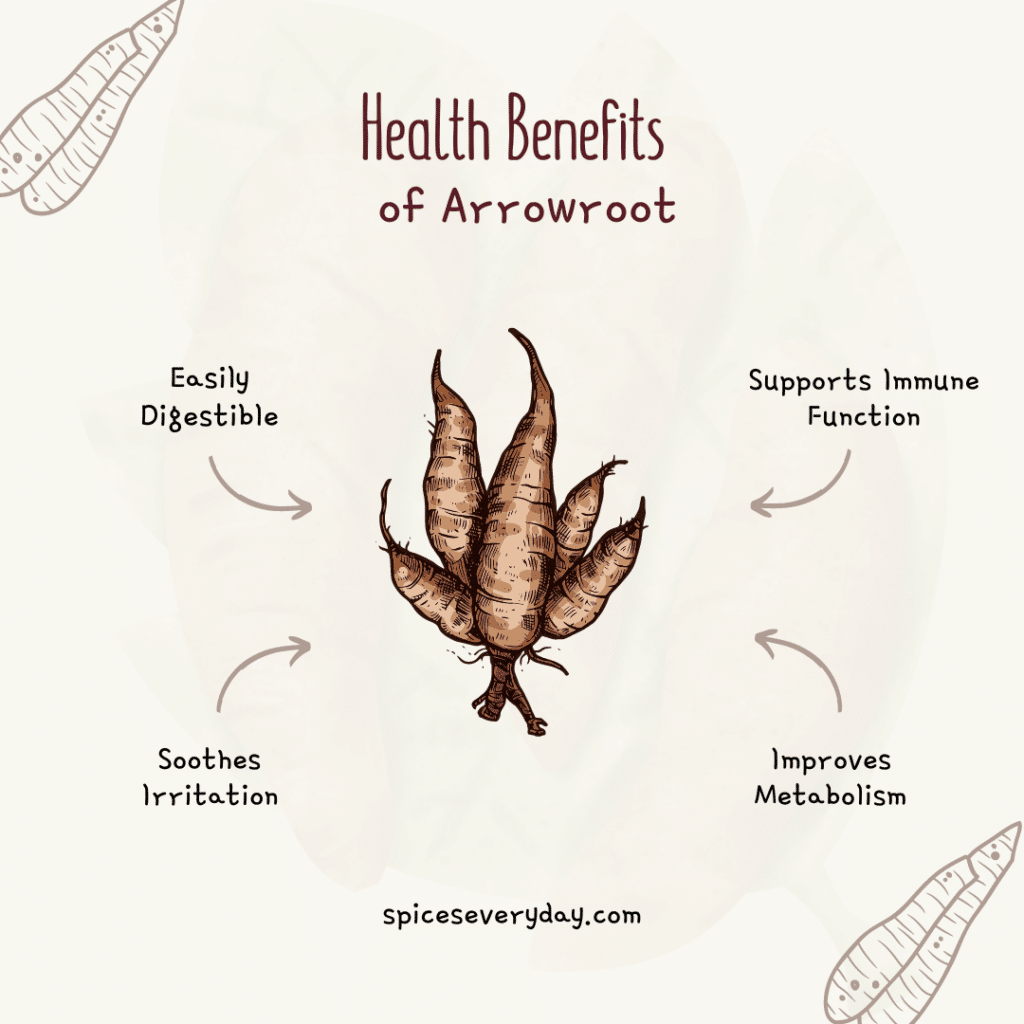Table of Contents
Let’s talk about a kitchen superstar which transforms ordinary dishes into extraordinary delights: arrowroot powder! This incredible ingredient brings a silky texture and a subtle flavor, making it a secret weapon for chefs and home cooks alike. Thickening your favorite sauces to velvety perfection, baking light and airy gluten-free goodies, or crafting sumptuous puddings that melt in your mouth, arrowroot powder does it all! With a rich history and a treasure trove of health benefits, this ingredient is more than just a pantry staple; it’s your new culinary best friend! So, let’s talk about arrowroot powder in detail.
What is Arrowroot Powder?

Arrowroot powder, also known as Maranta arundinacea, is a fine, white powder extracted from the arrowhead root powder of the plant. The root is first peeled, washed, and ground into a fine pulp. The starch is extracted from this pulp and dried to create the powder. Besides, Maranta Arundinacea is prized for its neutral flavor and high digestibility, making it a popular choice in both culinary applications and medicinal uses.
Nutritional Profile

Arrowroot powder is low in calories and rich in carbohydrates, making it an excellent energy source. It also contains a modest amount of protein and is free from fats. While it doesn’t have a particularly high concentration of vitamins and minerals, it does provide small amounts of:
- Potassium
- Iron
- Calcium
- Magnesium
- Folate
Common Uses of Arrowroot Powder

Below are some of the common uses of arrowroot powder that make it a powerful ingredient.
1. Thickening Agent
One of the most common culinary applications for Maranta Arundinacea thickening is as a thickening agent in cooking. It works similarly to wheat flour but is gluten-free and less processed. Because it becomes clear when heated and doesn’t break down under acidic conditions, it’s ideal for thickening soups, sauces, and stews. Unlike cornstarch, it also does not impart a cloudy appearance or gritty texture to the food.
How to Use It?
To thicken soups, sauces, or stews, mix arrowroot powder with cold water to create a slurry and add it at the end of cooking. For every cup of liquid, use about one tablespoon of arrowroot powder.
2. Gluten-Free Baking
Maranta Arundinacea is widely used in gluten free baking as a replacement for wheat flour. It helps create light, fluffy baked goods by adding structure and binding ingredients without gluten. Often, arrowroot flour is mixed with almond flour or coconut flour for better results.
How to Use It?
In gluten-free recipes, replace part of the flour with arrowroot starch. A common ratio is 1/4 cup of arrowroot powder for every cup of almond flour or other gluten-free flour mix.
3. Crisping and Frying
Arrowroot powder is an excellent alternative to cornstarch when creating a crispy coating for fried foods. Its fine texture helps achieve a light, crunchy exterior without making the food greasy. It also holds up well under high heat, which is ideal for frying.
How to Use It?
Dredge meats, vegetables, or tofu in Maranta Arundinacea before frying for a crisp finish. Alternatively, mix it with flour or breadcrumbs for a textured coating.
4. Pudding and Custard
Because arrowroot powder gels well and becomes smooth when heated, it’s perfect for making silky puddings and custards. Unlike flour-based thickeners, arrowroot powder produces a glossy finish without leaving a starchy taste.
You can check out the detailed recipe for arrowroot custard in this article.
How to Use It?
Use arrowroot starch in place of cornstarch or flour when making pudding or custard. Dissolve it in cold milk or water first, then add it to the mixture.
5. Skin Care
Arrowroot powder is also used in natural skincare products due to its absorbent and softening properties. It helps absorb excess moisture from the skin, making it a popular ingredient in homemade deodorants and dry shampoos. It is also soothing for skin irritation, such as diaper rash or sunburn.
How to Use It?
You can add Maranta Arundinacea to homemade lotions or deodorants or dust it on the skin as a natural baby powder alternative.
Health Benefits of Arrowroot Powder

Arrowroot powder is versatile in cooking and offers several health benefits. These benefits stem primarily from its easy digestibility and content of resistant starch, supporting gut health. Let’s explore the main health benefits of arrowroot powder:
1. Easily Digestible
This powder is gentle on the digestive system, making it ideal for those with sensitive stomachs, gluten-free diets, or people recovering from illness.
- Excellent for people with celiac disease or gluten intolerance.
- Helps individuals with digestive disorders like irritable bowel syndrome (IBS).
2. Rich in Resistant Starch
Resistant starch in arrowroot starch acts like fiber, supporting a healthy digestive system by feeding beneficial gut bacteria.
- Improves gut health by promoting the growth of good bacteria.
- Helps treat diarrhea and other digestive discomforts.
3. Supports Immune Function
Arrowroot flour contains folate, which is essential for cell repair and immune function, helping the body fend off infections.
- Helps produce healthy cells and boost the immune response.
- Reduces the risk of folate deficiency, which can impair immunity.
4. Improves Metabolism and Energy
Arrowroot powder’s rich carbohydrate content provides an immediate source of energy, supporting metabolic processes.
- Provides a quick energy boost, especially useful during recovery.
- Enhances metabolism through its digestible carbohydrates.
5. Soothes Irritation
When applied topically, arrowroot powder can help reduce skin irritation by absorbing moisture and reducing friction on the skin.
- Commonly used to treat diaper rash or sunburn.
- Provides natural relief for skin irritations like rashes.
How to Add Arrowroot Powder to Your Diet?

There are many ways to add this powder to your daily meals. From thickening sauces to adding it to baked goods, it’s easy to include in your kitchen.
Below are some simple methods to use arrowroot powder:
1. In Smoothies
Maranta Arundinacea can be added to smoothies for a natural energy boost and to improve the texture of your drink.
- Adds thickness without changing the flavor of the smoothie.
- Provides a quick source of digestible carbohydrates.
2. In Soups and Stews
Maranta Arundinacea is perfect for thickening soups, sauces, and stews without altering the taste or texture of the dish.
- Creates a smooth, glossy consistency in soups.
- Does not break down in acidic conditions, unlike cornstarch.
3. As a Gluten-Free Substitute
Arrowroot starch can be used as part of a gluten-free diet, improving the texture of baked goods.
- Ideal for making gluten-free bread, cookies, and cakes.
- Lightens and adds structure to gluten-free recipes.
4. In Puddings and Desserts
Use Maranta Arundinacea starch in place of cornstarch for making puddings and desserts, ensuring a smooth and creamy texture.
- Provides a glossy, smooth finish to puddings and custards.
- Prevents starchy aftertaste in desserts.
5. In Frying Recipes
Arrowroot powder creates a light, crispy coating on fried foods, making it perfect for frying vegetables, tofu, or meat.
- Gives fried foods a crunchy texture without making them greasy.
- It withstands high heat, ensuring a consistent fry.
Final Words
Summing up this discussion, when stored properly in a cool, dry place, arrowroot powder has an extended shelf life. However, pay attention to expiration dates and check for signs of spoilage to ensure the quality of your stored arrowroot powder. Does arrowroot powder go bad? Like any product, arrowroot powder can expire if not kept in airtight containers with tight-fitting lids. In the kitchen and beyond, arrowroot powder offers many benefits, especially for those on a gluten-free or vegan diet seeking easy-to-digest ingredients.
Gluten-Free Treat!

